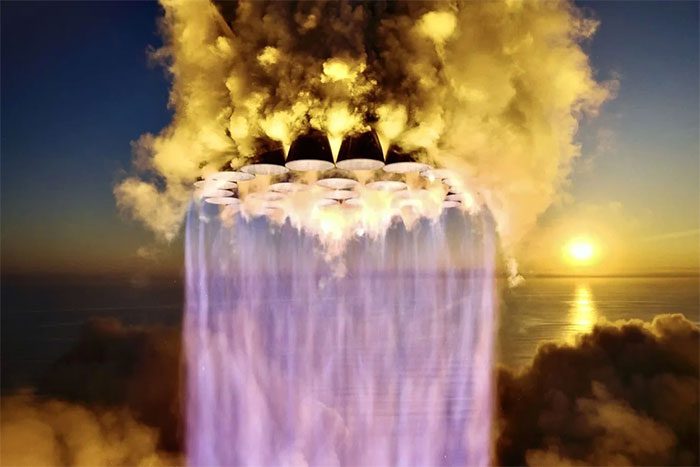SpaceX recently announced an upgraded version of the Starship rocket, enhancing its power and increasing its range.
The recent tests mark a significant milestone in the development of SpaceX’s most powerful rocket, aiming to realize the ambition of low-cost interplanetary travel.
The second test, conducted on November 18, lasted about 8 minutes and showed significant improvements over the first test.

The moment 33 powerful Raptor engines equipped on the Super Heavy booster of the Starship rocket exploded during the second test (Photo: SpaceX).
SpaceX introduced a new stage separation technique, known as “hot staging.” The upper section of the rocket successfully separated with 6 engines ignited while still attached to the Super Heavy booster.
Recently, SpaceX announced changes to the Starship version 2 (V2), which experts have praised as highly sophisticated.
SpaceX CEO Elon Musk pointed out that this new version contains more fuel to power the engines, has a reduced empty mass, and operates with high precision.
Major upgrades have been made to the second stage of the Starship rocket. This stage is positioned above the Super Heavy booster, which is equipped with up to 33 powerful Raptor engines.
According to Payload, Starship V2 may incorporate several modifications, such as the upper section using nine Raptor engines instead of six as in the previous version and increasing the fuel load. This will alter the shape of the fuel tank, potentially increasing the height of the Starship rocket by 5 to 10 meters.
For the third test flight, Elon Musk announced that the rocket could be installed on the launch pad within the next 3-4 weeks, although the exact timeline has not been confirmed.
Experts believe that during the second test, the Starship rocket made significant progress, and SpaceX is likely to continue launching at the beginning of 2024.
New Stage Separation Technique
Typically, when a multi-stage rocket reaches a certain altitude during flight, the lower stage is discarded (in some rockets, the first stage can land back on Earth), after which the upper section ignites its engines and continues to propel the spacecraft into orbit.
This sequence creates a brief period when no engines are active, known as the coast phase.
However, the Starship rocket operates quite differently; it employs the hot staging principle. Specifically, the ignition of the upper stage engines will occur while still attached to the first stage.
This method is not new; it ensures an almost instantaneous and continuous thrust transition, thereby eliminating the delay between stages.
This technique is particularly advantageous for heavy launch pads or missions that require high precision in timing and trajectory management.
SpaceX aims to refine this technique on the Starship rocket to enhance launch efficiency. The company is also seeking to optimize the accuracy and performance of spaceflights, opening new prospects for space exploration and interplanetary travel.
Some sources suggest that SpaceX may continue to use the first version of the Starship rocket for the next launch before the company tests the upgraded version.


















































